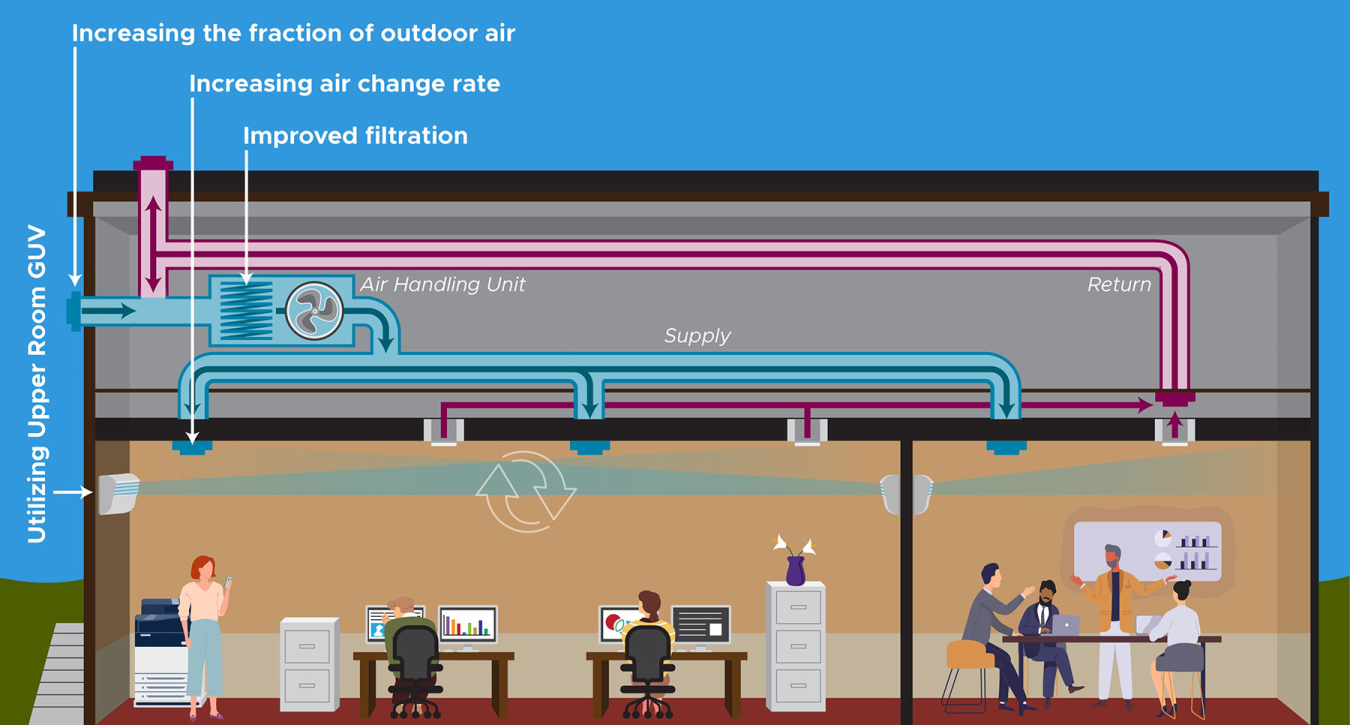
Excellent indoor air quality (IAQ) is an essential feature of healthy buildings. Benefits to the health and wellbeing of building occupants can in turn provide large economic benefits, but design and operation to deliver these benefits may impact building energy use. Germicidal ultraviolet (GUV) radiation, also known as UV germicidal irradiation (UVGI), is a method of air and surface treatment that may be more effective and energy efficient to reduce airborne disease transmission than alternatives such as energy-intensive high-ventilation solutions. Emerging GUV technologies represent an opportunity to realize additional energy savings through fixture design and application practices while maintaining the germicidal benefits. Currently, LED GUV sources and fixtures have relatively low efficiency and lifetime but there is headroom to improve through increased source efficiency, improved fixture design, and enhanced reliability. In conjunction with proper ventilation and filtration, GUV is a promising technology for providing optimal IAQ to building occupants.
Ongoing research supported by DOE looks to improve our understanding of this emerging technology and its potential to deliver safer, healthier, and more energy-efficient buildings.
CALiPER Product Testing
Pacific Northwest National Laboratory (PNNL) is testing commercially available GUV lamps and fixtures using industry-standard test methods. CALiPER GUV testing provides objective product performance information, evaluates performance claims, informs testing methods and standards, and identifies needed improvements.
- CALiPER GUV Round 2 analyzes the independently tested performance of eight GUV upper-room luminaires marketed for use in occupied spaces and purchased between March and June 2023. (October 2024)
- CALiPER GUV Round 1 analyzes the independently tested performance of 13 UV-C towers and whole-room luminaires purchased between February and July 2022. (September 2023)
Field Studies
Field evaluations will assess and demonstrate real-world application of GUV technologies, evaluating effectiveness, energy use, safety, and more.
Simulation Studies
Simulation studies characterize and quantify effectiveness, energy efficiency, decarbonization, and electrification benefits across building types and climate zones.
Both ASHRAE and the U.S. Centers for Disease Control and Prevention recently released new clean air targets to reduce the transmission of airborne diseases in buildings that are much higher than previous building ventilation standards. If these new targets are implemented using traditional HVAC ventilation approaches, building energy use and carbon emissions may drastically increase.
Comparison of effectiveness and energy use of airborne pathogen mitigation measures to meet clean air targets in a prototypical office building (Journal article, June 2024)
Related Research
- Energy Implications of Using Upper Room Germicidal Ultraviolet Radiation and HVAC Strategies to Combat SARS-CoV-2 (2022 ACEEE Summer Study article, August 2022)
- Operating Lifetime Study of UV LED Products (Report, April 2022)
- Initial Benchmarks of UV LEDs and Comparisons with White LEDs (Report, November 2021)
Roundtables
- Germicidal Ultraviolet (GUV) R&D Meeting (August 2022)
- Germicidal Ultraviolet (GUV) R&D Meeting Report (March 2022)
- Germicidal Ultraviolet (GUV) R&D Meeting Report (February 2021)

